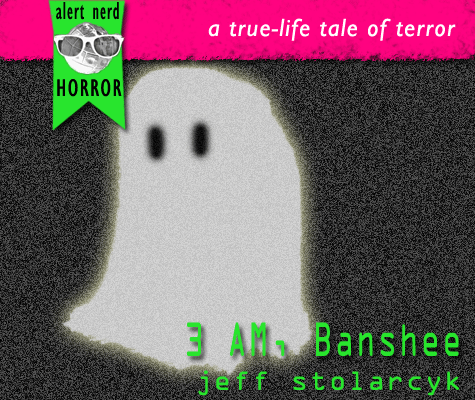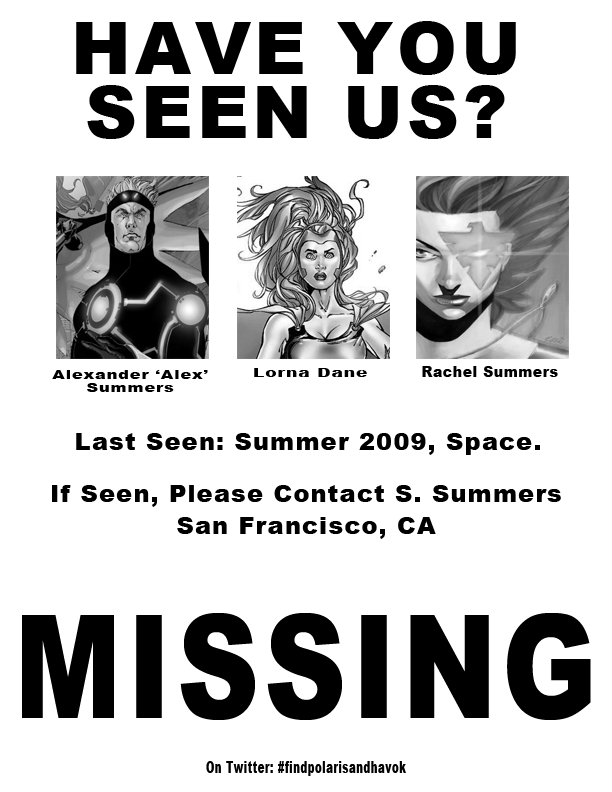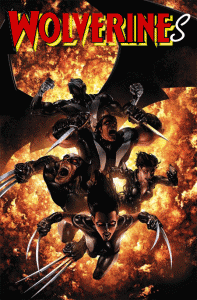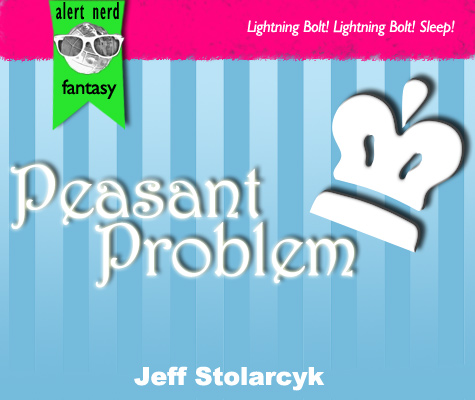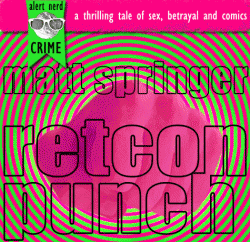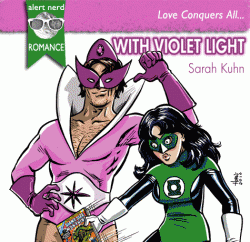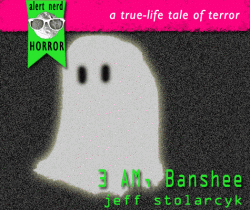3AM, Banshee
[In September 2008, Jeff Stolarcyk participated in a professional paranormal investigation. He survived, and this is his unvarnished account of the incident. A version of this essay appears in Grok #3 – Nameless Horror.]
It’s three AM in the Banshee’s basement, and the temperature is dropping rapidly. It’s gone from 65 degrees down to 52 over a period of thirty minutes. I’m standing facing the center of the room, one hand on my voice recorder, the other holding my Flip camera up to record. To my right, Joe asks, “Are you a male entity?†No answer. There is nobody in the center of the room, just more recorders, more cameras and a lone K2 meter in the center of the floor. The LEDs on the K2 meter dance between one lit and none lit. The K2 measures electromagnetism, and electromagnetism is linked to ghosts.
“Make the device go off twice for yes,†he instructs we-don’t-know-who, motioning to the meter placed on the floor two meters away from any of the four of us. Within thirty seconds, one beep sounds in the silence, followed after a pause by another. Two lights.
“Are there other entities in this room with you?†we had already asked it. Beep Beep. Two lights.
“Is there an evil entity in this room?†Beep Beep Beep Beep Beep Beep; no delay at all. All the lights are bright and steady.
The ghost, as a literary construct, is great even if ghost movies aren’t ever as great as they could be in the post-Poltergeist age. As a long-time, dyed-in-the-wool horror buff, I’ve got an unnatural fascination with ghosts, even though I’m not always of the opinion that they exist. My horror fandom led me to a similar eerie fixation on real-life ghost hunters, the ones found on Sci Fi and Discovery and the History Channel, and especially the ones that guest on that venerable fringe-culture radio staple Coast To Coast AM.
So it’s not exactly surprising that, in search of nameless horror, I went looking for ghosts with a local group of paranormal investigators.
In late September, Joe – the leader of a local group of professional ghost hunters – called me and invited me along with them to investigate The Banshee, a local pub in Scranton, Pennsylvania. Employees had contacted Joe’s group about a pair of full-body apparitions and other paranormal events, including one report of a physical attack in the basement of the bar. The staff have their own rumors about turn-of-the-century mass graves in the basement of the building, and several patrons corroborate the activity the staff has experienced.
I flip my cell phone closed and tell a coworker, “The Banshee is haunted.” He nods slowly, the nod that people nod when they’re accommodating idiocy. “Yeah,” he tells me. “I know.” It’s amazing how many people will casually admit to believing in ghosts. People believe all sorts of things that they think of as normal, especially the things that aren’t that normal at all.
Myself, I’ve had my moments. I’ve spent the night in a room where a woman died and felt watched all night. I’ve gotten chills in 80 degree heat while walking past a Louisiana graveyard. They’re not enough to dispel my natural skepticism, but they are good anecdotes when the topic arises and, like I’ve said, I’m fascinated by the phenomenon.
And yet the Banshee is haunted and I’m the last person to know about it. Despite having been a patron for years. During my graduate fellowship days, I’d schedule tutoring sessions there in order to keep my daily diet of draft cider and potato soup free from interruption. I still had dinner or drinks at the pub at least once a month. I’d been a patron since the bar opened its doors and never once had I been spooked, scared or startled. When I heard that we were going to investigate the building on my ghost hunting ride-along, my curiosity was piqued. Upon hearing the news, several friends and acquaintances freely admitted that they’d heard odd noises in the Banshee or seen anachronistic figures out of their peripheral vision, drawing back the curtain on a side of the sprawling Irish pub that I’d never seen before. My bar, where I once got wild applause for heckling a folk singer who refused to sing old revoultionary songs, was holding out on me. I was about to receive an education, though, and I’d be in the company of experts.
Nothing at all could go wrong.
(500) Days of MPDG?
Today, on Twitter, Caroline started up a convo about the Manic Pixie Dream Girl archetype and why it’s bad/whether women should ‘take it back’. As is the natural course of such conversations, various parties threw out their favorite MPDG characters and, of course, Zooey Deschanel – or more accurately Summer, from Marc Webb’s (500) Days of Summer – got tossed out. While ZD kind of emanates MPDG constantly like an immortal firefly trapped in some sort of nerd crush object mason jar, though, I don’t think that Summer fits the bill at all.
Summer isn’t a typical Omega Male romcom, though it looks suspiciously like one at times. Ultimately, it exposes the main problem with the OM/MPDG relationship as it’s presented in the type of movie that I’ll datedly call a ‘Zach Braff Film’: that it is obsessed with its gloomy male protagonist to the point that the female lead is an extension of the male lead, a panacea to his dysfunctions, and nothing more. Which is fine, I guess, if you’re telling a story about a guy who gets over because of the love of a good woman. But is that the best version of the story you could be telling? UP told that story in two minutes and then kept going and treated Carl and Ellie as a unit (so much so that her absence through much of the film is like a character itself). Don’t luxuriate on it for ninety minutes unless you have something new to say, right?
But Summer….
Summer is a movie about Tom trying to make his life into a Zach Braff Film. He lays that template over Summer Finn, and is completely blind (though the audience is not) to the fact that she doesn’t fit inside the confines of it. Though she initially appears manic and pixieish because of her fear of commitment and her reticence, she is neither. She is operating in a system that she believes in and is comfortable with.
The point, of course, is that Tom is a self-defeating ass. It’s only after he finishes with Summer that he’s able to kickstart his artistic dreams. Staying with her – staying with that fantasy version of what your life wants to be – was only going to make him stagnant and complacent.
And yes, the Autumn thing at the end of the film is a groaner, but it doesn’t undermine the message of the movie, chiefly because – on the surface, in the few moments we have with her – she is a better fit for Tom, and Tom has changed enough to ask her out. She seems neither M nor P and is his peer (a fellow architect), while Summer, as a secretary, was a rung beneath him (is that classist? Maybe? It’s there in the film, it’s not just me I swear).
What do you think? Who is your favorite Manic Pixie Dream Girl? Are they always a bad thing?
Bring Them Home
Where have the Starjammers been?
Fantastic Fangirl Caroline says:
For real, anybody in panels or meeting X-people at SDCC, ask about Lorna & Alex & Rachel. For justice! #findpolarisandhavok
Download a larger version of this missing poster, suitable for printing and posting at your preferred comics vendor.
Second Coming Postmortem
At the end of Brian M. Bendis and Olivier Coipel’s House of M miniseries, Magneto’s daughter Wanda – the former Avenger known as The Scarlet Witch – uttered “No More Mutants” and, thanks to her reality-altering powers, the world’s mutant population, which was once on a trajectory to overtake homo sapiens within a century, was reduced to under two hundred souls. While some happy few characters who lost their powers had them restored (Polaris, Professor Xavier, Magneto and Quicksilver), others like Jubilee and Mirage were permanently depowered. Mutant births stopped. The status quo for the X-Men changed and Xavier’s dream of peaceful coexistence had been killed. How, after all, can humans peacefully coexist with mutants if the mutants are all extinct?
Since then, the focus of the franchise has become bleak and militaristic. Religious fundamentalists attacked the school and killed a significant number of the teenage students. Xavier’s school was blown up yet again and this time, instead of rebuilding, the X-Men relocated to an isolated compound/bunker in San Francisco and then, less than a year later, moved again to an offshore island fortress built on the ruins of Magneto’s Asteroid M.* Bereft of hope and beset on all sides by the government, by zombie X-Men, by anti-mutant groups, by the ghost of Cyclops’s ex-wife and any number of other miscellaneous threats, their new start in the Bay Area has only been an exercise in backing the team into smaller and smaller boxes until they were literally trapped within an impassable bubble placed around San Francisco by Bastion, a mutant hating robot simultaneously from the future and the 1990s.
The hooks on which this storyline have hung have been a series of crossover events that have been unofficially dubbed “The Messiah Trilogy” by the creators responsible for them. Messiah CompleX deals with the first mutant birth since M-Day. The baby, christened Hope, is sought after by nearly every group in the X-verse, including the X-Man Bishop, who thinks that he can prevent his own post-apocalyptic future timeline from occurring if he simply murders a baby. Because this always works. To protect the child, Hope is sent into the future with Cable (another cringeworthy 1990s character who had managed to be redeemed by Mike Carey and Fabian Nicieza – a mutant supersoldier from a barren, post-apocalyptic future with improbable guns and a bitchin’ metal arm). This is, at best, a miscalculation, as the history of the X-Men franchise has never been one for positive, thriving futures or good parenting, and Cable ends up raising Hope in increasingly more post-apocalyptic settings as Bishop chases them through time, destroying the world that he is sure won’t exist anymore once he kills the girl. Bishop may be a cop and a mutant but he has never been accused of being smart. And as a mutant cop, you’d think he’d have more reservations about killing a baby than he does. Babies can’t commit crimes.
During the hunt for the mutant baby, Cyclops tasked Wolverine with putting together a wetworks squad of X-Men who have claws or love knives, a resurrected X-Force.
Because X-Men don’t kill (except when they do), Wolverine and his crew must keep their existence secret from their teammates. Cyclops bears that burden the worst, clearly haunted by his decision to keep a cabal of assassins at his beck and call. Eventually, during the Messiah War crossover, Cyclops sends X-Force into the future to retrieve Cable and Hope and bring them home. They fail their mission, but manage to help save Hope from Bishop, Apocalypse and Cable’s evil clone Stryfe (again, dear reader: 1990s) before returning home. Deadpool playing Tic-Tac-Toe is also involved, and that particular scene is the highlight of the entire story.
Finally, Cable and Hope came home, inciting Second Coming, the third act of the trilogy. Tying together plots from Cable and X-Force, it left all the X-Men scrambling to react to Bastion’s cabal of resurrected villains and had a high body count – Ariel, Sack (Sack was still alive?), Vanisher, Nightcrawler and Cable were killed, Karma and Hellion were left crippled. Utopia was destroyed. Beast resigned from the team in disgust. X-Force’s existence is revealed to the other X-Men, which leads to strained relationships and consistent complaints that Cyclops has gone too far. It goes something like this:
ANY X-MAN: YOU HAVE GONE TOO FAR!
CYCLOPS/WOLVERINE: YOU DON’T UNDERSTAND MY BURDEN! THIS IS ABOUT SURVIVAL!
ANY X-MAN: X-MEN DON’T KILL – YOU’VE CROSSED THE LINE!
CYCLOPS/WOLVERINE: LEADING IS HARD!
ANY X-MAN: WHAT WOULD JEAN SAY ABOUT YOUR SECRET MURDER POLICE?
CYCLOPS/WOLVERINE: *IMPORTANT SILENCE*
ANY X-MAN: BFFs NO MORE!
Despite the crushing losses and frayed personal relationships, it also signals a significant change in the status quo. Because possibly Hope is the new host of the Phoenix — the universal embodiment of all life unless you are from the planet D’Bari in which case it is the universal embodiment of holy shit panic we’re all gonna d-.** But really, we don’t know what Hope is – her powers are intermittent and she seems to glom them off of whoever is around her at the time they manifest. Near Cyclops, she has eye beams. Near Cable, she has Cable powers. I continue to suspect that this is related to Hope’s encounter with Rogue as an infant, the one that cleaned the slate of Rogue’s powers and laid the groundwork for her to finally gain control over her abilities. I can’t shake the feeling that the Phoenix has been a red herring ever since the possibility was first raised at the end of Messiah CompleX. From an editorial perspective, it means they cannot keep fruitlessly teasing that Phoenix (albeit in the guise of Jean Grey) is coming back, which is 90% of Marvel’s X-Men marketing efforts.
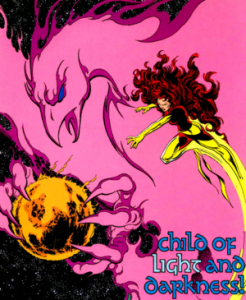
The feeling I get when reading or thinking about Second Coming is one of fatigue. The kind of fatigue you get from running on a treadmill for five years. The whole storyline since Hope’s birth has been running in place until it was time to bring Hope back and despite some talented storytellers taking us through those paces, it has only been talented running in place. Yes, the backdrops changed, much in the way that my treadmill can pretend that I’m running the Golden Gate Trail or through the streets of New York or up Mount Everest or whatever, but none of that actually ever means that I’ve moved. The debate over the necessity of X-Force and the constant harping on survival both seemed forced and both seem like filler. And only now, now that Hope is back three years later and maybe the Phoenix but maybe whatever else, we can move forward. There are new mutants again. Hope is looking for her family. Captain American wants the world to like the X-Men. Oh, and something with vampires.
I know comics are cyclical. I know that change in comics is illusory. But nothing that happens in Second Coming ever seems more than perfunctory or purgatorial, the same state that the X-franchise has been in since “No More Mutants” was uttered. For an event story in fifteen parts that is the closing leg of a trilogy of multi-part event stories, not much has happened. The ‘River City Ransom’ format of the early half was abandoned in the latter parts as San Francisco came under attack and things only seemed to keep happening in order to draw the story out as long as possible. Cable and X-Force have to take Cypher into the future to do something that Doug can easily do without effort. Magneto fights robots. Cyclops makes a speech. People are mean to Cyclops. The story feels so mechanical at times that I wonder if Matt Fraction or Zeb Wells or whoever is really just a pen name for Madison Jeffries. The only emotional impacts come from deaths and dismemberments or from characters crossing lines they swore they’d never cross again. The story beats throughout Second Coming were tired and trite, the deaths meaningless because of it, and the threat never as real as it should have felt. It was also not the story about the Phoenix that we were promised by the creators responsible for it. Other than what I’m perceiving as a move back to San Francisco from Utopia (which was about a mile or so from San Francisco) and the addition of Hope to the cast and the temporary subtraction*** of a few cast members, nothing of consequence has been done.
When Matt Fraction took over the title, I hoped for the same verve and hopeful energy that permeates his Invincible Iron Man. It existed for a few issues and then was lost in the plodding of the metaplot. With Second Coming behind us, I look forward to seeing that energy again.
*Personally, I would have preferred it immensely if Utopia was built out of Cable’s island nation of Providence, which was destroyed late in Mike Carey’s X-Men run.
**truncated mid-word because the speaker has been immolated.
*** the only X-Man that stays dead is Jean Grey.
Velocity #1
[Note: A review copy of Velocity #1 was provided by the publisher.]
I can’t tell you five meaningful things about Cyberforce. Maybe not even three.
I don’t tell you this as a slight against Image Comics or Top Cow or Marc Silvestri, but to establish that I don’t know anything meaningful about a superhero franchise that has been around for nearly 20 years now. I have a gap in my comics knowledge shaped almost exactly like the O5-era Image books.
The good news is that Velocity doesn’t require that you to carry any of that baggage. It would bog you down, anyway, and Velocity, just like its title character, is all about going fast.
Speed is inherent in Ron Marz’s mandate here, as the book gracefully caroms from action scene to action scene, slowing down to offer up exposition, but never stopping. Carin Taylor’s origin, powers and teammates are all explained without the book grinding to a halt. The reader also sees Carin’s personality in action – youthful, heroic, in love with her powers but a little maudlin about their cost. There are also killer robots and a race-against-the-clock plot that set a tone of kinetic superhero action.
Also shouldering the credit for Velocity‘s success is Kenneth Rocafort. Rocafort – who’s probably best known for his work on Paul Dini’s Madame Mirage – uses every tool at his disposal to keep the book moving along quickly and his trademark sketchy style is perfectly suited to a title character that moves at Mach 3. He draws Carin like a runner with a runner’s body, makes her costume feel like the superheroine version of a roller derby uniform and (without aping it) reminds me of Karl Kerschl’s work on The Flash, which epitomizes fast, loose, kinetic storytelling for me.
If this is a light week for you, and you’re looking for a short-term comics romance, this is the comic out this week that I’d recommend to you. It’s the first of four issues, has a minimum of baggage and a surplus of action and speed, and is more accessible than most recent mainstream first issues.

